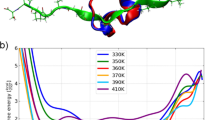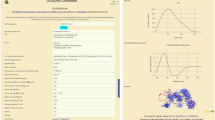Abstract
The Atomic Solvation Parameter (ASP) model is one of the simplest models of solvation, in which the solvation free energy of a molecule is proportional to the solvent accessible surface area (SAS) of its atoms. However, until now this model had not been incorporated into the Self-Consistent Mean Field Theory (SCMFT) method for modelling sidechain conformations in proteins. The reason for this is that SAS is a many-body quantity and, thus, it is not obvious how to define it within the Mean Field (MF) framework, where multiple copies of each sidechain exist simultaneously. Here, we present a method for incorporating an SAS-based potential, such as the ASP model, into SCMFT. The theory on which the method is based is exact within the MF framework, that is, it does not depend on a pairwise or any other approximation of SAS. Therefore, SAS can be calculated to arbitrary accuracy. The method is computationally very efficient: only 7.6% slower on average than the method without solvation. We applied the method to the prediction of sidechain conformation, using as a test set high-quality solution structures of 11 proteins. Solvation was found to substantially improve the prediction accuracy of well-defined surface sidechains. We also investigated whether the methodology can be applied to prediction of folding free energies of protein mutants, using a set of barnase mutants. For apolar mutants, the modest correlation observed between calculated and observed folding free energies without solvation improved substantially when solvation was included, allowing the prediction of trends in the folding free energies of this type of mutants. For polar mutants, correlation was not significant even with solvation. Several other factors also responsible for the correlation were identified and analysed. From this analysis, future directions for applying and improving the present methodology are discussed.
Similar content being viewed by others
References
Smith, P.E. and Pettitt, B.M., J. Phys. Chem., 98 (1994) 9700.
Dill, K.A., Biochemistry, 29 (1990) 7133.
Leach, A.R. Molecular Modelling: Principles and Applications. Addison Wesley Longman Ltd., Essex, 1996.
Chan, H.S. and Dill, K.A., Ann. Rev. Biophys. Biomol. Struct., 26 (1997) 425.
Warwicker, J. and Watson, H.C., J. Mol. Biol., 157 (1982) 671.
Warshel, A. and Levitt, M., J. Mol. Biol., 103 (1976) 227.
Lee, B. and Richards, F.M., J. Mol. Biol., 55 (1971) 379.
Herman, R.B., J. Phys. Chem., 76 (1972) 2754.
Chothia, C.H., Nature, 248 (1974) 338.
Reynolds, J.A., Gilbert, D.B. and Tanford, C., Proc. Natl. Acad. Sci. USA, 71 (1974) 2925.
Eisenberg, D. and MacLachlan, A.D., Nature, 319 (1986) 199.
Wesson, L. and Eisenberg, D., Protein Sci., 1 (1992) 227.
Janardhan, A. and Vajda, S., Protein Sci., 7 (1998) 1772.
Wilson, C., Gregoret, L.M. and Agard, D.A., J. Mol. Biol., 229 (1993) 996.
Cregut, D., Liautard, J.-P. and Chiche, L., Protein Eng, 7 (1994) 1333.
Cardozo, T., Totrov, M. and Abagyan, R., Proteins, 23 (1995) 403.
Schiffer, C.A., Caldwell, J.W., Kollman, P.A. and Stroud, R.M., Mol. Simul., 10 (1993) 121.
von Freyberg, B., Richmond, T.J. and Braun, W., J. Mol. Biol., 233 (1993) 275.
Lee, C., J. Mol. Biol., 236 (1994) 918.
Desmet, J., de Maeyer, M., Hazes, B. and Lasters, I., Nature, 356 (1992) 539.
Koehl, P. and Delarue, M., J. Mol. Biol., 239 (1994) 249.
Street, A.G. and Mayo, S.L., Folding & design, 3 (1998) 253.
Voigt, C.A., Gordon, D.B. and Mayo, S.L., J. Mol. Biol., 299 (2000) 789.
Serrano, L., Bycroft, M. and Fersht, A.R., J. Mol. Biol., 218 (1991). 465
Fersht, A., Matouschek, A. and Serrano, L., J. Mol. Biol., 224 (1992). 771
Serrano, L., Kellis Jr., J.T., Cann, P., Matouschek, A. and Fersht, A.R., J. Mol. Biol., 224 (1992) 783.
Serrano, L., Matouschek, A. and Fersht, A.R., J. Mol. Biol., 224 (1992) 805.
Matouschek, A., Serrano, L. and Fersht, A.R., J. Mol. Biol., 224 (1992) 819.
Matouschek, A., Serrano, L., Meiering, E.M., Bycroft, M. and Fersht, A.R., J. Mol. Biol., 224 (1992) 837.
Serrano, L., Matouschek, A. and Fersht, A.R., J. Mol. Biol., 224 (1992) 847.
Hill, T.L. Statistical Mechanics, McGraw-Hill, New York, 1956.
Mendes, J., Soares, C.M. and Carrondo, M.A., Biopolymers, 50 (1999) 111.
Jackson, R.M., Gabb, H.A. and Sternberg, M.J.E., J. Mol. Biol., 276 (1998) 265.
Mendes, J., Baptista, A.M., Carrondo, M.A. and Soares, C.M., Proteins, 37 (1999) 530.
van Gunsteren, W.F. and Berendsen, H.J.C. Groningen molecular simulation (GROMOS) library manual, Biomos B. V., Biomolecular Software, Groningen, The Netherlands, 1987.
Solmajer, T. and Mehler, E.L., Protein Eng., 4 (1991) 911.
Solmajer, T. and Mehler, E.L., Int. J. Quant. Chem., 44 (1992) 291.
Smith, L.J., Mark, A.E., Dobson, C.M. and van Gunsteren, W.F., Biochemistry, 34 (1995) 10918.
Shrake, A. and Rupley, J.A., J. Mol. Biol., 79 (1973) 351.
Wolfenden, R., Andersson, L., Cullis, P.M. and Southgate, C.C.B., Biochemistry, 20 (1981) 849.
Ben-Naim, A., J. Phys. Chem., 82 (1978) 792.
Sharp, K.A., Nicholls, A., Friedman, R. and Honig, B., Biochemistry, 30 (1991) 9686.
Vriend, G., J. Mol. Graph., 8 (1990) 52.
Kendall, M. and Stuart, A. The advanced theory of statistics, Charles Griffin & Company Ltd., London, 1977.
Privalov, P.L. and Makhatadze, G.I., J. Mol. Biol., 232 (1993) 660.
Dill, K.A. and Shortle, D., Ann. Rev. Biochem., 60 (1991) 95.
Shortle, D., FASEB J., 10 (1996) 27.
Gordon, D.B., Marshall, S.A. and Mayo, S.L., Curr. Opin. Struct. Biol., 9 (1999) 509.
Hellinga, H.W. and Richards, F.M., Proc. Natl. Acad. Sci. USA, 91 (1994) 5803.
Baldwin, E.P., Hajiseyedjavadi, O., Baase, W.A. and Matthews, B.W., Science, 262 (1993) 1715.
Eriksson, A.E., Baase, W.A., Zhang, X.J., Heinz, D.W., Blaber, M., Baldwin, E.P. and Matthews, B.W., Science, 255 (1992) 178.
Desjarlais, J.R. and Handel, T.M., J. Mol. Biol., 289 (1999) 305
Harbury, P.B., Tidor, B. and Kim, P.S., Proc. Natl. Acad. Sci. USA, 92 (1995) 8408.
Koehl, P. and Delarue, M., Nature Struct. Biol., 2 (1995) 163.
Author information
Authors and Affiliations
Rights and permissions
About this article
Cite this article
Mendes, J., Baptista, A.M., Carrondo, M.A. et al. Implicit solvation in the self-consistent mean field theory method: sidechain modelling and prediction of folding free energies of protein mutants. J Comput Aided Mol Des 15, 721–740 (2001). https://doi.org/10.1023/A:1012279810260
Issue Date:
DOI: https://doi.org/10.1023/A:1012279810260




